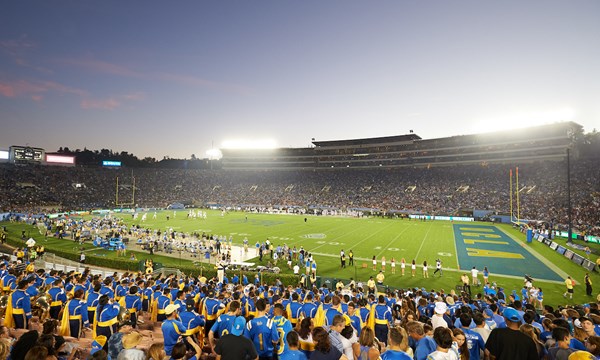
The aftershocks of this summer’s decision by the University of Southern California and the University of California, Los Angeles, to forgo the Pacific-12 Conference for the Big Ten Conference continue to reverberate across the college sports landscape—with even more disruptive changes in college football governance reportedly under consideration.
The move by USC and UCLA, which is due to take effect in 2024, was the latest in a decade-long seismic shift in the landscape of big-time college football and men’s basketball that has obliterated historical geographic boundaries and rivalries in universities’ pursuit of greater revenues.
This week brought two developments that laid bare both the financial windfall that attracted the West Coast powers to abandon their Pac-10 brethren and the extent of the unhappiness felt by those left behind.
First, the Big Ten announced Thursday that it had signed media rights agreements with several major television networks that would be worth at least $1 billion a year beginning in 2023. The league’s expiring agreement is worth $430 million a year, meaning the conference will have significantly more than doubled the revenues it distributes to its member institutions. The New York Times characterized the seven-year agreement as the “richest-ever television agreement for a college athletic league.” While the media agreements cover all sports sponsored by the Big Ten, football drove the negotiations, just as it has fueled the conference realignment activity.
If the Big Ten’s eye-popping new television contracts show why the traditionally Midwestern league was so eager to recruit two of the highest-profile West Coast sports powers, a meeting Wednesday of the University of California system’s Board of Regents suggested the lengths to which advocates for the Pac-12 might go to try to hold it together.
The Los Angeles Times reported Wednesday night that the UC board had discussed the possibility of trying to block UCLA’s move to the Big Ten.
“All options are on the table,” Regent John Perez told the Times, “up to and including” taking steps to stop UCLA from leaving the Pac-12 and its UC peer, the University of California, Berkeley. “We’re going to look at what all the different options look like and then the board will assert itself in terms of what its desired outcome is.”
The Times noted that many observers had assumed UCLA had the right to make the move via a 1991 system policy that delegated authority to campus chancellors to execute their own contracts, including intercollegiate athletic agreements.
But the system’s lawyer, Charlie Robinson, told the regents that the board’s chairman had the authority “to say, ‘I’m directing you, in this instance, to stand down,’ … and the board will be exercising authority in this area.”
The idea that the UC system might take legal or other action to block a major decision by one of its campuses shows just how much the money-driven politics around big-time sports can affect the larger higher ed landscape. Cutthroat choices by institutional leaders to put themselves in the best position for the future can have direct negative consequences for longtime allies and collaborators.
Even Bigger Changes Possible
Pulling back the frame, nothing makes that clearer than discussions about the future of college football governance nationally. Despite its slowly eroding authority, and occasional threats by the biggest sports powers to walk away to seek more self-control (and share less money), the National Collegiate Athletic Association has been able to keep its 1,200 or so members as part of the organization.
But the desire of the largest 50 or 60 football powers to dictate their own fates poses the biggest threat to keeping the NCAA together. ESPN reported this week that the board that governs the College Football Playoff had “briefly discussed the possibility of restructuring how college football is governed, with the idea presented of major college football potentially being governed outside of the NCAA.” The playoff group manages the postseason competition for the largest football powers, but the sport remains governed by NCAA rules around academic eligibility, recruiting and other matters.
The biggest sports powers often feel as if they lack autonomy over their programs, because some of their decisions must be made in conjunction with colleges that have significantly smaller budgets.
But any move by the football powers to break away from the NCAA could have significant implications, including some they don’t intend. Foremost among them is the risk that distancing highly commercialized sports like football and basketball from more clearly amateur programs (think men’s volleyball and women’s softball) could make it harder to justify the exemption that makes much of the revenue in college athletics free from federal taxation.
Critics have increasingly argued that the most visible collegiate sports do not warrant being considered part of the educational mission that justifies the tax exemption for nonprofit colleges. The NCAA provides a link between the major sports powers and hundreds of colleges and universities in Divisions I, II and III with more clearly “amateur” teams and arguably gives the big-time programs cover.
Choosing to distance themselves from those Division II and Division III sports programs—and potentially alienating the scores of universities whose football programs would be left out of a new football governance structure—could draw scrutiny from politicians, the IRS or others who could threaten the tax exemption of college sports, among other possible side effects.
from Inside Higher Ed | News https://ift.tt/ftuZovE


No comments:
Post a Comment